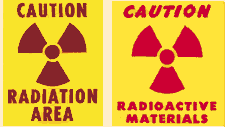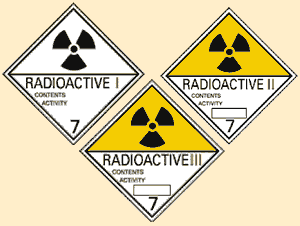Ancillary Personnel Radiation Safety Training Module
Ancillary personnel radiation safety training test
After completing this training module please go here to complete your exam in IRIS. If you prefer/need a hard copy exam please contact the RSO for assistance.
Introduction
Laboratories in the chemistry and the reactor use radioactive materials. Reed College has developed this radiation safety training module to help ancillary personnel recognize radioactive materials, and identify the hazards and the safeguards one should use when working around these materials. Ancillary personnel include maintenance and custodial workers, students, community safety officers, telecommunications and networking personnel, and others. While these safeguards should protect you from unsafe conditions in most situations, there is no substitute for your personal knowledge and vigilance when working in areas where radioactive materials are used. The guiding principle of radiation protection is to avoid all unnecessary exposures. Reed promotes the principles of ALARA and is obligated to keep radiation exposure to all employees As Low As Reasonably Achievable. This module shall be reviewed upon your employment and triennially thereafter.
Education
Radiation is probably the most feared and least understood of all the hazards we encounter in our lives. We cannot see, hear, smell, or feel it. However, radiation is actually one of the simpler hazards to measure and control. Unsafe amounts of radiation are also the least frequently encountered; the dangers from common chemicals, fire hazards, and physical accidents are much more common.
Radiation is simply a form of energy. The energy may be in the form of particles or electromagnetic waves, similar to light, microwaves, lasers, radio and television waves. It is all around us every day. No matter what we do or where we live, we have exposure to "background radiation." Background radiation comes from the sun, stars, rocks, soil, and food we eat. These doses are quite small.
In addition to background radiation, you may work around areas that contain radioactive materials in certain laboratories on Reed campus. The following information will help you:
- Recognize where these materials are stored and used.
- Know what to do when you work in a room that contains radioactive materials.
- Understand general restrictions for working in these rooms.
- Control your exposure to radioactive materials should problems occur.
Recognizing Radioactive Materials
The Reed College Radioactive Materials program strives to ensure the safety of all employees. Both state and federal guidelines provide a framework for this program. The college depends on you to recognize the posted signs, identify hazards and safeguards, and to report any problems to your supervisor, and subsequently to the Radiation Safety Officer, April Sams (at extension 7788).
Warning signs indicate the presence of radioactive materials. These signs have a magenta, red or black symbol, called a trefoil, on a yellow background.

Packages used to transport radioactive materials also have labels. These will have the number 7 at the bottom of the diamond.

Reed College uses a third type of label or sign for equipment that produces x-rays.

Hazards and Control
We can think of radiation like a sun lamp or tanning bed. Skin will burn if exposed to it too long, or is too close, or is not protected by sun block. Similarly, we can use three basic radiation safety techniques to control exposures. They are Time, Distance, and Shielding.
- Time: Limit your time around the area.
- Distance: Maximize your distance from the area to at least 6 feet.
- Shielding: Keep a wall or door between you and the radiation area.
Radiation is measured using several units. The most common of these, the rem, measures the biological damage caused by radiation. As mentioned previously, doses encountered in every day life are typically very small. In fact, we use millirem(mrem) or thousandths of a rem to measure it. The average person in the United States receives about 200 to 400 millirem every year. This dose is mostly from natural sources of radiation.
Some Typical Annual Exposures
| Source | mrem per year | ||
| Natural sources (=82%) | Radon gas | 198 | |
| Cosmic radiation | 28 | ||
| Food, water, air that we ingest or inhale | 29 | ||
| Human-made sources (=18%) | Medical x-rays | Chest | 20 mrem/x-ray |
| GI series | 210 mrem/x-ray | ||
| Dental | 1 mrem/x-ray | ||
| Road surfaces | 1 mrem/ 2500 miles of driving | ||
| Home construction | Stone or concrete | 45 | |
| Wood | 35 | ||
| Consumer products* | 11 | ||
| Nuclear power | 0.01 | ||
| Sleeping with partner or other | 0.1 | ||
*Regularly smoking cigarettes adds about 1300 mrem/year to one's exposure.
Authorized users of radioactive materials wear a personal monitoring device to track their exposure while working. Because ancillary personnel will not have this type of exposure, no personal monitoring is required. Safety during pregnancy should not be a serious concern; however, any employee may request to consult with the Radiation Safety Officer for additional information.
Work areas containing radioactive materials or machines have added safety measures. The primary user or health physicist take a sample of these areas by rubbing the area with filter paper and analyzing it for radioactivity. For example, they take samples:
- Biweekly in areas where they use radioactive materials
- Monthly in storage areas (facilities)
- Every six months for sources with a high amount of radioactivity (>3.7 microcuries)
- Every three months for alpha emitters (>10 microcruries)
Controlled Areas
Caution Radiation Area
- Routine cleaning occurs in rooms where there are radiation-producing machines or radioactive materials. Safeguards are in place to ensure the machines are not turned on and that the materials are stored safely. Trash disposal in this area is authorized, if not labeled radioactive.
- Never eat, drink, or smoke in rooms where radioactive materials are used.
Caution Radioactive Materials
- Do not handle, move, or remove bags or containers labeled "Radioactive Material."
- Do not handle or dispose of trash in this area unless requested or authorized by the Radiation Safety Officer or her/his designee.
- Do not clean floors or counter tops unless requested by the Radiation Safety Officer.
X-ray Producing Equipment
Reed College also has several rooms where instruments produce x-rays. A label or plate will identify such rooms. If you are asked to work in a room with this equipment:
- Contact the authorized user for safety instructions prior to entry. Some experiments run unattended.
Emergency Actions
If you encounter a liquid or solid spill in an area posted as "Radioactive Materials," close the door and notify your supervisor and/or the Radiation Safety Officer.
Emergency telephone numbers
Radiation Safety Officer (RSO): 503-777-7788
Reactor Director: 503-777-7222
Community Safety: 503-788-6666